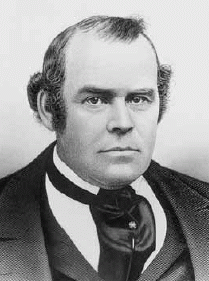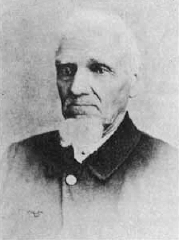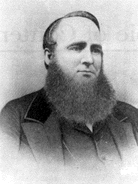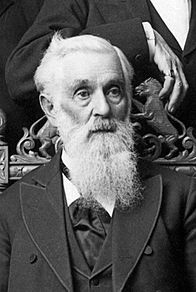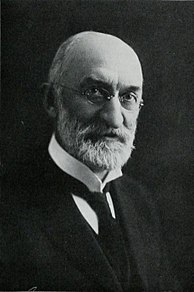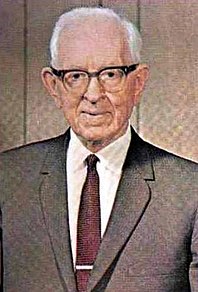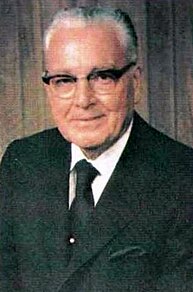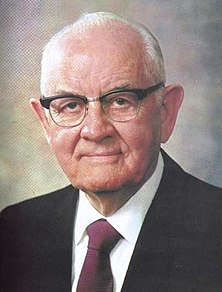President of the Quorum of the Twelve Apostles is a priesthood calling in the Church of Jesus Christ of Latter-day Saints. Normally, the President of the Quorum of the Twelve is the most senior apostle in the church, aside from the President of the Church. When the President of the Church dies, it is the President of the Quorum of the Twelve who becomes the new church president. The calling of President of the Twelve has been held by 27 men, 16 of whom have gone on to become President of the Church. The current President of the Quorum of the Twelve is Dallin H. Oaks. Since Oaks is a counselor in the First Presidency, M. Russell Ballard is currently serving as acting president.
In the Latter Day Saint movement, an apostle is a "special witness of the name of Jesus Christ who is sent to teach the principles of salvation to others." In many Latter Day Saint churches, an apostle is a priesthood office of high authority within the church hierarchy. In many churches, apostles may be members of the Quorum of the Twelve and First Presidency of the church. In most Latter Day Saint churches, modern-day apostles are considered to have the same status and authority as the Biblical apostles.
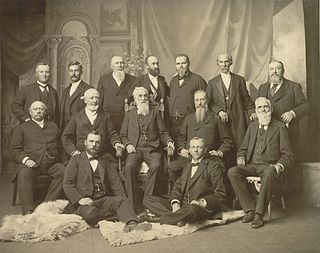
In the Church of Jesus Christ of Latter-day Saints, the Quorum of the Twelve Apostles is one of the governing bodies in the church hierarchy. Members of the Quorum of the Twelve Apostles are apostles, with the calling to be prophets, seers, and revelators, evangelical ambassadors, and special witnesses of Jesus Christ.
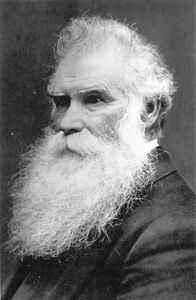
Orson Pratt Sr. was an American mathematician and religious leader who was an original member of the Quorum of the Twelve Apostles of the Church of Christ. He became a member of the Quorum of the Twelve of the Church of Jesus Christ of Latter-day Saints and was a leading Mormon theologian and writer until his death.

Charles William Penrose was a member of the Quorum of the Twelve Apostles of the Church of Jesus Christ of Latter-day Saints from 1904 to 1911. Penrose was also a member of the First Presidency, serving as a counselor to church presidents Joseph F. Smith and Heber J. Grant from 1911 until his death.

Orson Hyde was a leader in the early Latter Day Saint movement and a member of the first Quorum of the Twelve Apostles. He was the President of the Quorum of the Twelve Apostles of the Church of Jesus Christ of Latter-day Saints from 1847 to 1875 and was a missionary of the LDS Church in the United States, Europe, and the Ottoman Empire.
Lineal succession was a doctrine of the Latter Day Saint movement, whereby certain key church positions were held by right of lineal inheritance. Though lineal succession is now largely abandoned, the offices connected with the practice were the President of the Church and the Presiding Patriarch.
The succession crisis in the Latter Day Saint movement occurred after the death of Joseph Smith, the movement's founder, on June 27, 1844.
A Rigdonite is a member of the Latter Day Saint movement who accepts Sidney Rigdon as the successor in the church presidency to the movement's founder, Joseph Smith Jr. The early history of the Rigdonite movement is shared with the history of the Latter Day Saint movement, but as of the 1844 succession crisis becomes distinct. Sidney Rigdon and other church leaders, including Brigham Young and James J. Strang, presented themselves as leaders of the movement and established rival church organizations. Rigdon's group was initially headquartered in Pittsburgh, Pennsylvania. It was known at one point as the Church of Jesus Christ of the Children of Zion, and its adherents are referred to as Rigdonites, or sometimes "Pennsylvania Latter Day Saints" or "Pennsylvania Mormons." The only surviving organization that traces its succession back to Rigdon's organizations is The Church of Jesus Christ, founded by a group of Rigdon's followers led by William Bickerton.

Brigham Young Jr. served as president of the Quorum of the Twelve Apostles of the Church of Jesus Christ of Latter-day Saints from 1899 until his death. His tenure was interrupted for one week in 1901 when Joseph F. Smith was the president of the Quorum.
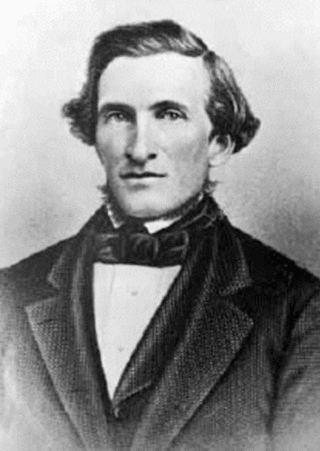
Jedediah Morgan Grant was a leader and an apostle of the Church of Jesus Christ of Latter-day Saints. He was member of the First Council of the Seventy from 1845 to 1854 and served in the First Presidency under church president Brigham Young from 1854 to 1856. He is known for his fiery speeches during the Reformation of 1856, earning the nickname "Brigham's Sledgehammer". Grant is the father of Heber J. Grant, who later served as President of the Church.

John Willard Young was a leader in the Church of Jesus Christ of Latter-day Saints. He is one of the few individuals to have been an LDS Church apostle and member of the First Presidency without ever being a member of the Quorum of the Twelve Apostles.
Acting President of the Quorum of the Twelve Apostles is a priesthood calling in the Church of Jesus Christ of Latter-day Saints.
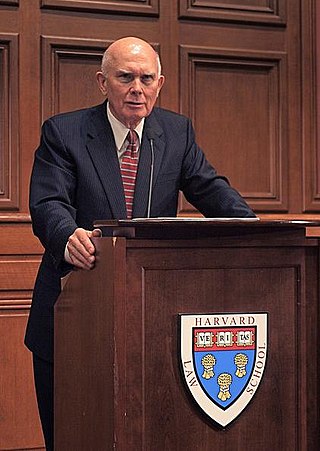
The First Presidency, also called the Quorum of the Presidency of the Church or simply the Presidency, is the presiding governing body of the Church of Jesus Christ of Latter-day Saints. It is composed of the President of the Church and his counselors. The First Presidency currently consists of Russell M. Nelson and his two counselors: Dallin H. Oaks and Henry B. Eyring.
In the Latter Day Saint movement, the Quorum of the Twelve is one of the governing bodies or (quorums) of the church hierarchy organized by the movement's founder Joseph Smith and patterned after the Apostles of Jesus. Members are called Apostles, with a special calling to be evangelistic ambassadors to the world.

Ronald Anderson Rasband is a member of the Quorum of the Twelve Apostles of the Church of Jesus Christ of Latter-day Saints. He has been a general authority of the church since 2000. Currently, he is the eleventh most senior apostle in the church.

Neil Linden Andersen is an American religious leader and former business executive who serves as a member of the Quorum of the Twelve Apostles of the Church of Jesus Christ of Latter-day Saints. He was sustained by church membership as an apostle on April 4, 2009, during the church's General Conference. At the time of his call to the Twelve, Andersen had been serving as an LDS general authority since 1993, including service in the Presidency of the Seventy from 2005 to 2009. Currently, he is tenth apostle in order of seniority in the church.
What follows is a list of events in chronological order that affected the membership of the Quorum of the Twelve Apostles of the Church of Jesus Christ of Latter-day Saints.

The President of the Church is the highest office of the Church of Jesus Christ of Latter-day Saints. It was the office held by Joseph Smith, the church's founder. The church's president is its leader and the head of the First Presidency, its highest governing body. Latter-day Saints consider the president of the church to be a "prophet, seer, and revelator" and refer to him as "the Prophet", a title that was originally given to Smith. When the name of the president is used by adherents, it is usually prefaced by the title "President". Russell M. Nelson has been the president since January 14, 2018.








